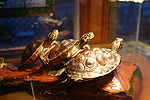
Ectotherm
Encyclopedia

Reptile
Reptiles are members of a class of air-breathing, ectothermic vertebrates which are characterized by laying shelled eggs , and having skin covered in scales and/or scutes. They are tetrapods, either having four limbs or being descended from four-limbed ancestors...
s regulate their body temperature by basking in the sun. The opposite of ectothermy is endothermy, where heat is primarily generated as a result of internal metabolic
Metabolism
Metabolism is the set of chemical reactions that happen in the cells of living organisms to sustain life. These processes allow organisms to grow and reproduce, maintain their structures, and respond to their environments. Metabolism is usually divided into two categories...
processes. Many ectotherms are also poikilotherm
Poikilotherm
A poikilotherm is an organism whose internal temperature varies considerably. It is the opposite of a homeotherm, an organism which maintains thermal homeostasis. Usually the variation is a consequence of variation in the ambient environmental temperature...
s, meaning their temperature varies over a wider range than homeotherm
Homeotherm
Homeothermy is thermoregulation that maintains a stable internal body temperature regardless of external influence. This temperature is often, though not necessarily, higher than the immediate environment...
s.
Ectotherms are animals that warm their bodies by absorbing heat from their surroundings. In most ectotherms, the body temperature fluctuates with changes in the surrounding temperature; these ectotherms are called poikilotherm
Poikilotherm
A poikilotherm is an organism whose internal temperature varies considerably. It is the opposite of a homeotherm, an organism which maintains thermal homeostasis. Usually the variation is a consequence of variation in the ambient environmental temperature...
s. The body temperature of snakes, for example, cools in cold weather and warms up in hot weather. However, most marine fishes and invertebrates live in water that stays at constant temperature. Their body temperature, therefore, does not change, and these ectotherms are therefore considered homeotherm
Homeotherm
Homeothermy is thermoregulation that maintains a stable internal body temperature regardless of external influence. This temperature is often, though not necessarily, higher than the immediate environment...
s.
Adaptations
Certain ectotherm behaviors help regulate body temperature. To warm up, reptiles find sunny places, and stretch out for maximum exposure. If it gets too warm, lizards alternate between sun and shade. Amphibians warm up by moving into the sun or diving into warm water. They cool off by entering the shade. In cold weather, honey bees huddle together to retain heat. Butterflies and moths may orient their wings to maximize exposure to solar radiation in order to build up heat before takeoff. Many flying insects, such as honey bees and bumble bees, also raise their internal temperatures endothermically prior to flight, by contracting their flight muscles without moving their wings.In addition to behaviors, physiological adaptations help ectotherms regulate temperature. Diving reptiles conserve heat because their blood circulates inward toward the body core during a dive. The skin of bullfrogs secretes more mucus when it is hot, allowing more cooling by evaporation. Many ectotherms exist at a lower temperature during torpor, a state of slowed metabolism. This helps them survive a food shortage. If the food supply increases, they come out of torpor in a few hours.
Advantages and disadvantages
Ectotherms gain most of their heat from external sources such as sunlight energy, therefore they have less dependence on respiration for generation of heat. As a result, ectotherms such as reptiles can survive on just a single large meal per week. The advantage of this to ectotherms is that they are less vulnerable to fluctuations in food supply, increasing their chances of survival.Tropical ectotherms may be particularly vulnerable to climate warming and are experiencing large increases in metabolic rate and will have an increased need for food.

